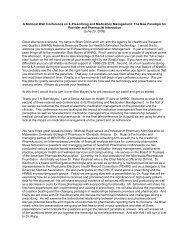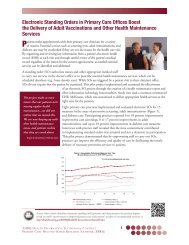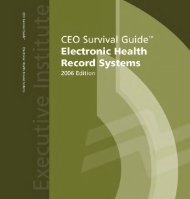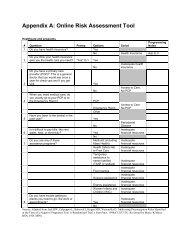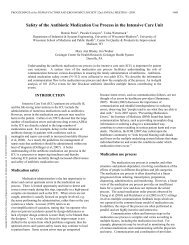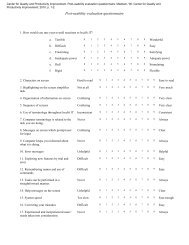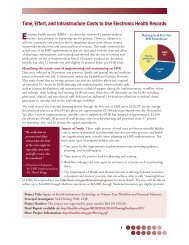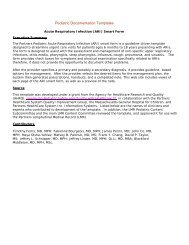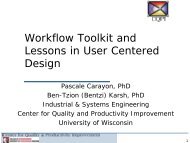Use of an Electronic Referral System to Improve the Outpatient ...
Use of an Electronic Referral System to Improve the Outpatient ...
Use of an Electronic Referral System to Improve the Outpatient ...
You also want an ePaper? Increase the reach of your titles
YUMPU automatically turns print PDFs into web optimized ePapers that Google loves.
Final ACTION Contract Report<br />
<strong>Use</strong> <strong>of</strong> <strong>an</strong> <strong>Electronic</strong> <strong>Referral</strong><br />
<strong>System</strong> <strong>to</strong> <strong>Improve</strong> <strong>the</strong> <strong>Outpatient</strong><br />
Primary Care–Specialty<br />
Care Interface<br />
Implementation<br />
H<strong>an</strong>dbook
This page intentionally left bl<strong>an</strong>k.
<strong>Use</strong> <strong>of</strong> <strong>an</strong> <strong>Electronic</strong> <strong>Referral</strong> <strong>System</strong> <strong>to</strong> <strong>Improve</strong> <strong>the</strong><br />
<strong>Outpatient</strong> Primary Care–Specialty Care Interface<br />
Implementation H<strong>an</strong>dbook<br />
Prepared for:<br />
Agency for Healthcare Research <strong>an</strong>d Quality<br />
U.S. Department <strong>of</strong> Health <strong>an</strong>d Hum<strong>an</strong> Services<br />
540 Gai<strong>the</strong>r Road<br />
Rockville, MD 20850<br />
www.ahrq.gov<br />
Contract No. HHSA 290200600017, TO #3<br />
Prepared by: RAND Corporation, S<strong>an</strong>ta Monica, CA<br />
Authors:<br />
Douglas S. Bell<br />
Sus<strong>an</strong> G. Straus<br />
Shinyi Wu<br />
Alice Hm Chen<br />
Margot B. Kushel<br />
AHRQ Publication No. 11(12)-0096-1-EF<br />
February 2012
This document is in <strong>the</strong> public domain <strong>an</strong>d may be used <strong>an</strong>d reprinted without permission except<br />
those copyrighted materials that are clearly noted in <strong>the</strong> document. Fur<strong>the</strong>r reproduction <strong>of</strong> those<br />
copyrighted materials is prohibited without <strong>the</strong> specific permission <strong>of</strong> copyright holders.<br />
Suggested Citation:<br />
Bell DS, Straus SG, Wu S, Chen AH, Kushel MB. <strong>Use</strong> <strong>of</strong> <strong>an</strong> <strong>Electronic</strong> <strong>Referral</strong> <strong>System</strong> <strong>to</strong><br />
<strong>Improve</strong> <strong>the</strong> <strong>Outpatient</strong> Primary Care–Specialty Interface: Implementation H<strong>an</strong>dbook. (Prepared<br />
by RAND Corporation under Contract No. HHSA 290-2006-00017, TO #3). AHRQ Publication<br />
No. 11(12)-0096-1-EF. Rockville, MD: Agency for Healthcare Research <strong>an</strong>d Quality. February<br />
2012.<br />
None <strong>of</strong> <strong>the</strong> investiga<strong>to</strong>rs has <strong>an</strong>y affiliations or fin<strong>an</strong>cial involvement that conflicts with <strong>the</strong><br />
material presented in this report.<br />
This project was funded by <strong>the</strong> Agency for Healthcare Research <strong>an</strong>d Quality (AHRQ), U.S.<br />
Department <strong>of</strong> Health <strong>an</strong>d Hum<strong>an</strong> Services. The opinions expressed in this document are those<br />
<strong>of</strong> <strong>the</strong> authors <strong>an</strong>d do not reflect <strong>the</strong> <strong>of</strong>ficial position <strong>of</strong> AHRQ or <strong>the</strong> U.S. Department <strong>of</strong><br />
Health <strong>an</strong>d Hum<strong>an</strong> Services.<br />
ii
Preface<br />
This project was funded as <strong>an</strong> Accelerating Ch<strong>an</strong>ge <strong>an</strong>d Tr<strong>an</strong>sformation in Org<strong>an</strong>izations <strong>an</strong>d<br />
Networks (ACTION) task order contract. ACTION is a 5-year implementation model <strong>of</strong> fieldbased<br />
research that fosters public–private collaboration in rapid-cycle, applied studies. ACTION<br />
promotes innovation in health care delivery by accelerating <strong>the</strong> development, implementation,<br />
diffusion, <strong>an</strong>d uptake <strong>of</strong> dem<strong>an</strong>d-driven <strong>an</strong>d evidence-based products, <strong>to</strong>ols, strategies, <strong>an</strong>d<br />
findings. ACTION also develops <strong>an</strong>d diffuses scientific evidence about what does <strong>an</strong>d does not<br />
work <strong>to</strong> improve health care delivery systems. It provides <strong>an</strong> impressive cadre <strong>of</strong> deliveryaffiliated<br />
researchers <strong>an</strong>d sites with a me<strong>an</strong>s <strong>of</strong> testing <strong>the</strong> application <strong>an</strong>d uptake <strong>of</strong> research<br />
knowledge. With a goal <strong>of</strong> turning research in<strong>to</strong> practice, ACTION links m<strong>an</strong>y <strong>of</strong> <strong>the</strong> Nation's<br />
largest health care systems with its <strong>to</strong>p health services researchers. For more information about<br />
this initiative, go <strong>to</strong> http://www.ahrq.gov/research/action.htm.<br />
iii
What Is e<strong>Referral</strong>?<br />
A HIPAA-compli<strong>an</strong>t, Web-based referral <strong>an</strong>d consultation system<br />
• Linked <strong>to</strong> electronic medical record (EMR), with au<strong>to</strong>-population <strong>of</strong> relev<strong>an</strong>t EMR data.<br />
• Referring providers enter free text referral questions.<br />
• M<strong>an</strong>da<strong>to</strong>ry use for enrolled specialty clinics.<br />
A new model for primary care – specialty care collaboration<br />
• Individualized review <strong>an</strong>d response <strong>to</strong> each referral by a designated specialist clinici<strong>an</strong><br />
(MD or NP).<br />
• Iterative communication between referring <strong>an</strong>d reviewing clinici<strong>an</strong>s until both agree that<br />
<strong>the</strong> patient ei<strong>the</strong>r does not need <strong>an</strong> appointment or <strong>the</strong> appointment is scheduled.<br />
A <strong>to</strong>ol that allows specialist reviewers <strong>to</strong>—<br />
• Redirect referrals if inappropriate for clinic or o<strong>the</strong>r options available.<br />
• Provide information for PCP m<strong>an</strong>agement <strong>of</strong> condition, with or without <strong>an</strong> appointment.<br />
• Request clarification <strong>of</strong> question or additional workup prior <strong>to</strong> specialty appointment.<br />
• Expedite specialty clinic appointments if clinically warr<strong>an</strong>ted.<br />
For more information on e<strong>Referral</strong>, contact Alice Chen at achen@medsfgh.ucsf.edu.<br />
iv
Contents<br />
Statement <strong>of</strong> <strong>the</strong> Problem ................................................................................................................ 1<br />
The Delivery <strong>System</strong>....................................................................................................................... 1<br />
<strong>Referral</strong> Process Prior <strong>to</strong> e<strong>Referral</strong> ................................................................................................. 3<br />
e<strong>Referral</strong> His<strong>to</strong>ry ............................................................................................................................. 5<br />
Technical Specifications ................................................................................................................. 5<br />
e<strong>Referral</strong> Overview ......................................................................................................................... 6<br />
e<strong>Referral</strong> Submission Process ................................................................................................... 8<br />
Initial Specialist Review ......................................................................................................... 15<br />
Specialist Reviewer Tools ....................................................................................................... 18<br />
Scheduling Process ................................................................................................................. 21<br />
Scheduled Appointments ........................................................................................................ 22<br />
Not Scheduled e<strong>Referral</strong>s ....................................................................................................... 27<br />
e<strong>Referral</strong> Documentation <strong>an</strong>d M<strong>an</strong>agement ........................................................................... 29<br />
e<strong>Referral</strong> Support .................................................................................................................... 37<br />
Clinic Implementation Process ..................................................................................................... 40<br />
Ongoing <strong>Improve</strong>ments ................................................................................................................ 41<br />
Impact <strong>of</strong> e<strong>Referral</strong> ....................................................................................................................... 41<br />
Decrease in Wait Times .......................................................................................................... 41<br />
High Levels <strong>of</strong> Primary Care Provide Acceptability .............................................................. 42<br />
<strong>Improve</strong>ments in Specialist Experience .................................................................................. 42<br />
Table<br />
Table 1. Wait times (in days) for <strong>the</strong> next available new patient appointment for four different<br />
medical specialty clinics ................................................................................................................. 5<br />
Figures<br />
Figure 1. S<strong>an</strong> Fr<strong>an</strong>cisco General Hospital’s Core <strong>Referral</strong> Network .............................................. 2<br />
Figure 2. Overview <strong>of</strong> computer networks accessing e<strong>Referral</strong> ..................................................... 3<br />
Figure 3. Sample completed referral form ...................................................................................... 4<br />
Figure 4. e<strong>Referral</strong> submission process .......................................................................................... 7<br />
Figure 5. <strong>Referral</strong> submission process with step 1 highlighted ...................................................... 7<br />
Figure 6. Patient search window ..................................................................................................... 8<br />
Figure 7. Initial e<strong>Referral</strong> window .................................................................................................. 8<br />
Figure 8. Specialty clinic or service selection window ................................................................... 9<br />
Figure 9. Referring provider screening questions window ............................................................. 9<br />
Figure 10. Referring provider screening questions window with reason ....................................... 9<br />
Figure 11. Sample urology clinic policy window, <strong>an</strong>d posted pre-referral guidelines window ... 10<br />
Figure 12. Referring provider selection window .......................................................................... 11<br />
Figure 13. Referring provider location window ........................................................................... 11<br />
Figure 14. Attending provider selection window ......................................................................... 12<br />
v
Figure 15. Patient information window ........................................................................................ 12<br />
Figure 16. St<strong>an</strong>dardized clinical information selection window .................................................. 13<br />
Figure 17. Initial specialist review window .................................................................................. 13<br />
Figure 18. <strong>Referral</strong> submission process with steps 2, 3, 4 highlighted ......................................... 14<br />
Figure 19. Reviewer response <strong>to</strong> referring provider window ....................................................... 14<br />
Figure 20. <strong>Referral</strong> submission process with steps 3, 4, 5 highlighted ......................................... 15<br />
Figure 21. Scheduling instructions window .................................................................................. 15<br />
Figure 22. Clinic configuration window ....................................................................................... 16<br />
Figure 23. e<strong>Referral</strong> news window ............................................................................................... 16<br />
Figure 24. Diagnostic test results window .................................................................................... 17<br />
Figure 25. Test results window with consult <strong>an</strong>d lab results ........................................................ 17<br />
Figure 26. Boilerplate library table ............................................................................................... 18<br />
Figure 27. Access <strong>an</strong>d role settings for clinic ............................................................................... 18<br />
Figure 28. Scheduler view with schedule lists .............................................................................. 19<br />
Figure 29. Scheduled appointment ............................................................................................... 20<br />
Figure 30. Consult<strong>an</strong>t view <strong>of</strong> scheduled appointments ............................................................... 20<br />
Figure 31. Scheduled appointment with running notes ................................................................ 21<br />
Figure 32. Scheduled appointment with multiple dated notes ...................................................... 21<br />
Figure 33. Appointment list .......................................................................................................... 22<br />
Figure 34. <strong>Outpatient</strong> e<strong>Referral</strong> form ............................................................................................ 22<br />
Figure 35. Scheduled appointment ............................................................................................... 23<br />
Figure 36. <strong>Referral</strong> submission process with steps 1, 3, 4, 5, 6 highlighted ................................. 23<br />
Figure 37. Current request status .................................................................................................. 24<br />
Figure 38. Consult<strong>an</strong>t view ........................................................................................................... 25<br />
Figure 39. Patient’s EMR ............................................................................................................. 26<br />
Figure 40. Referring provider worklist ......................................................................................... 27<br />
Figure 41. Primary care provider worklist .................................................................................... 28<br />
Figure 42. Referring location worklist .......................................................................................... 29<br />
Figure 43. Primary care clinic worklist ......................................................................................... 30<br />
Figure 44. Referring provider removing e<strong>Referral</strong> from worklist for designated time ................ 31<br />
Figure 45. e<strong>Referral</strong> being returned <strong>to</strong> worklist ............................................................................ 31<br />
Figure 46. Referring provider worklist ......................................................................................... 32<br />
Figure 47. Referring location worklist .......................................................................................... 32<br />
Figure 48. Ch<strong>an</strong>ge referring provider <strong>to</strong>ol .................................................................................... 33<br />
Figure 49. Audit trail for <strong>the</strong> eConsult <strong>to</strong> patient .......................................................................... 33<br />
Figure 50. e<strong>Referral</strong> suggestion box ............................................................................................. 34<br />
Figure 51. e<strong>Referral</strong> help <strong>an</strong>d FAQs ............................................................................................. 35<br />
Figure 52. e<strong>Referral</strong> news archives ............................................................................................... 36<br />
Figure 53. Clinics <strong>an</strong>d services requiring e<strong>Referral</strong>...................................................................... 36<br />
Figure 54. e<strong>Referral</strong> activity chart <strong>an</strong>d reviewer audit ................................................................. 37<br />
Appendix<br />
Appendix A: Acknowledgments ................................................................................................ A-1<br />
vi
University <strong>of</strong> California, S<strong>an</strong> Fr<strong>an</strong>cisco (UCSF), S<strong>an</strong><br />
Fr<strong>an</strong>cisco General Hospital (SFGH) e<strong>Referral</strong> Program<br />
Statement <strong>of</strong> <strong>the</strong> Problem<br />
Over <strong>the</strong> past decade, access <strong>to</strong> specialty care has become arguably one <strong>of</strong> <strong>the</strong> most pressing<br />
issues for safety net providers <strong>an</strong>d patients across <strong>the</strong> country, with wait times for some<br />
specialties extending <strong>to</strong> nearly a year. There is a dearth <strong>of</strong> specialists, particularly surgical<br />
specialists, who are willing <strong>to</strong> see uninsured <strong>an</strong>d Medicaid patients, resulting in a severe<br />
mismatch between supply <strong>of</strong> <strong>an</strong>d dem<strong>an</strong>d for specialty services. Compounding this crisis are<br />
inefficient referral processes notable for poor or absent communication between referring <strong>an</strong>d<br />
specialty providers, <strong>an</strong>d systems dependent on h<strong>an</strong>dwritten referrals <strong>an</strong>d unreliable faxes <strong>to</strong><br />
schedule appointments.<br />
S<strong>an</strong> Fr<strong>an</strong>cisco is no exception. S<strong>an</strong> Fr<strong>an</strong>cisco General Hospital (SFGH), through a<br />
partnership with <strong>the</strong> University <strong>of</strong> California, S<strong>an</strong> Fr<strong>an</strong>cisco (UCSF), serves as <strong>the</strong> primary<br />
provider <strong>of</strong> specialty care for <strong>the</strong> city’s 72,000 uninsured as well as m<strong>an</strong>y <strong>of</strong> its Medi-Cal <strong>an</strong>d<br />
Medicare patients. Prior <strong>to</strong> e<strong>Referral</strong>, <strong>the</strong> wait time for some routine specialty appointments was<br />
as long as 11 months.<br />
If a referring provider w<strong>an</strong>ted <strong>to</strong> expedite her patient’s appointment, she had <strong>to</strong> try <strong>to</strong> reach<br />
(call, email, or page) <strong>an</strong>d convince a specialist <strong>of</strong> <strong>the</strong> urgency <strong>of</strong> <strong>the</strong> request. There was no<br />
equitable mech<strong>an</strong>ism for specialists <strong>to</strong> triage urgent cases, as <strong>the</strong>y only heard about patients<br />
when <strong>the</strong> referring provider made <strong>an</strong> extra effort <strong>to</strong> contact <strong>the</strong>m.<br />
When <strong>the</strong> patient did present for care, <strong>the</strong> specialist would <strong>of</strong>ten find that <strong>the</strong> initial<br />
evaluation was ei<strong>the</strong>r incomplete or had not been forwarded, or that <strong>the</strong> consultative question<br />
was unclear. Sometimes <strong>the</strong> referral was unnecessary. Less frequently, but more concerning, <strong>the</strong><br />
specialist might find that <strong>the</strong> patient’s case was urgent <strong>an</strong>d should have been seen earlier.<br />
The system was frustrating <strong>to</strong> primary care providers, specialists, <strong>an</strong>d patients alike.<br />
The Delivery <strong>System</strong><br />
S<strong>an</strong> Fr<strong>an</strong>cisco General Hospital is part <strong>of</strong> <strong>the</strong> S<strong>an</strong> Fr<strong>an</strong>cisco Department <strong>of</strong> Public Health<br />
(DPH), which also includes a network <strong>of</strong> community clinics <strong>an</strong>d a skilled nursing facility. The<br />
City’s sole public hospital, SFGH operates 252 acute care beds. In fiscal year 2007-2008, SFGH<br />
provided 529,098 outpatient visits, 29 percent <strong>of</strong> which were specialty care visits <strong>an</strong>d 20 percent<br />
<strong>of</strong> which were for diagnostic services. The payer mix for <strong>the</strong>se visits was 34 percent uninsured,<br />
28 percent Medi-Cal <strong>an</strong>d 18 percent Medicare. Major specialty clinics at SFGH include (but are<br />
not limited <strong>to</strong>) cardiology, derma<strong>to</strong>logy, endocrinology, gastroenterology, general surgery,<br />
hema<strong>to</strong>logy-oncology, nephrology, neurology, neurosurgery, obstetrics <strong>an</strong>d gynecology,<br />
ophthalmology, orthopedics, o<strong>to</strong>laryngology, plastic surgery, podiatry, pulmonary, rheuma<strong>to</strong>logy<br />
<strong>an</strong>d urology. SFGH’s physici<strong>an</strong> services are provided by UCSF faculty, fellows <strong>an</strong>d residents.<br />
The hospital currently uses a hybrid paper <strong>an</strong>d electronic medical record (EMR).<br />
1
Figure 1. S<strong>an</strong> Fr<strong>an</strong>cisco General Hospital’s Core <strong>Referral</strong> Network<br />
SFGH’s core referral network for specialty clinics consists <strong>of</strong> a diverse group <strong>of</strong> 27 primary<br />
care clinics that have differing levels <strong>of</strong> access <strong>to</strong> <strong>the</strong> DPH electronic medical record (EMR) (see<br />
Figure 1). The clinics include 5 hospital-based primary care clinics, 12 Community-Oriented<br />
Primary Care (COPC) clinics, <strong>an</strong>d 10 S<strong>an</strong> Fr<strong>an</strong>cisco Community Clinic Consortium (SFCCC)<br />
clinics. <strong>Referral</strong>s for diagnostic studies (e.g., MRI) originate from both primary care <strong>an</strong>d<br />
specialty clinics.<br />
• Hospital-based primary care clinics include family medicine, internal medicine,<br />
pediatrics, positive health (HIV primary care), <strong>an</strong>d women’s health clinics. The family<br />
medicine, internal medicine, pediatrics, <strong>an</strong>d women’s health clinics serve as continuity<br />
clinic training sites for UCSF residents. While <strong>the</strong> physici<strong>an</strong>s are UCSF employees, <strong>the</strong><br />
clinic staff are city employees. Toge<strong>the</strong>r, <strong>the</strong>se five clinics serve as primary care home for<br />
more th<strong>an</strong> 30,000 patients. These clinics have immediate access <strong>to</strong> <strong>the</strong> DPH EMR, with<br />
all but <strong>the</strong> women’s health clinic having computer terminals in each patient care room.<br />
• COPC clinics include a network <strong>of</strong> twelve primary care clinics located in neighborhoods<br />
across S<strong>an</strong> Fr<strong>an</strong>cisco that <strong>to</strong>ge<strong>the</strong>r serve as <strong>the</strong> primary care home for nearly 45,000<br />
patients. Both physici<strong>an</strong> <strong>an</strong>d clinic staff are City employees. Each <strong>of</strong> <strong>the</strong> clinics has<br />
reliable access <strong>to</strong> <strong>the</strong> DPH EMR. M<strong>an</strong>y, but not all, COPC clinics have terminals in each<br />
patient care room.<br />
• Consortium clinics consist <strong>of</strong> 10 independent clinics, including 3 Federally Qualified<br />
Health Centers <strong>an</strong>d three free clinics. SFCCC clinics <strong>to</strong>ge<strong>the</strong>r serve over 70,000 people<br />
per year. Each health center employs its own physici<strong>an</strong>s <strong>an</strong>d clinic staff, <strong>an</strong>d each has a<br />
local Practice M<strong>an</strong>agement <strong>System</strong> whose primary function is billing; two have <strong>an</strong> EMR.<br />
Connectivity <strong>to</strong> <strong>the</strong> DPH Network <strong>an</strong>d EMR is provided via a limited number <strong>of</strong><br />
workstations configured with <strong>the</strong> DPH’s VPN (Virtual Private Network) s<strong>of</strong>tware.<br />
2
To access <strong>the</strong> DPH EMR, SFCCC users must complete three au<strong>the</strong>ntication steps: (1) login<br />
<strong>to</strong> <strong>the</strong> VPN, (2) login <strong>to</strong> <strong>the</strong> Active Direc<strong>to</strong>ry network domain (via Citrix Portal), <strong>an</strong>d finally (3)<br />
login <strong>to</strong> <strong>the</strong> DPH EMR. Once connected, response time has been poor <strong>an</strong>d <strong>the</strong>re have been<br />
frequent reports <strong>of</strong> network disconnections. Figure 2 below shows <strong>an</strong> overview <strong>of</strong> <strong>the</strong> network<br />
<strong>to</strong>pology <strong>an</strong>d interfaces among <strong>the</strong> org<strong>an</strong>izations that participate in e<strong>Referral</strong>.<br />
Figure 2. Overview <strong>of</strong> computer networks accessing e<strong>Referral</strong><br />
<strong>Referral</strong> Process Prior To e<strong>Referral</strong><br />
Prior <strong>to</strong> e<strong>Referral</strong>, all specialty referrals required completion <strong>of</strong> a paper referral form (Figure<br />
3). The referring provider h<strong>an</strong>dwrote <strong>the</strong> patient name <strong>an</strong>d telephone number, <strong>the</strong> referring<br />
provider name, provider ID, practice site, telephone <strong>an</strong>d fax number. If <strong>the</strong> referring provider<br />
was a resident, he had <strong>to</strong> enter this same information for <strong>an</strong> attending provider. There was <strong>an</strong> 8.5”<br />
by 1.5” area <strong>to</strong> write in <strong>the</strong> reason for consultation, including pertinent his<strong>to</strong>ry, physical findings,<br />
<strong>an</strong>d diagnostic data.<br />
The completed form was faxed over <strong>to</strong> <strong>the</strong> specialty clinic, typically while <strong>the</strong> patient was<br />
still in clinic. Some clinics required a phone call prior <strong>to</strong> faxing <strong>the</strong> form; o<strong>the</strong>rs required a<br />
follow-up phone call <strong>to</strong> make <strong>the</strong> appointment after <strong>the</strong> fax was received. <strong>Referral</strong>s were<br />
scheduled on a first-received, first-scheduled basis. There was no centralized method <strong>to</strong> track<br />
referrals. If <strong>the</strong> receiving fax machine was not functioning or had run out <strong>of</strong> paper, <strong>the</strong> referral<br />
was unlikely <strong>to</strong> be completed.<br />
3
Figure 3. Sample completed referral form<br />
As mentioned previously, if a referring provider w<strong>an</strong>ted <strong>to</strong> expedite her patient’s<br />
appointment, she had <strong>to</strong> contact (call, email, or page) <strong>an</strong>d convince a specialty provider <strong>of</strong> <strong>the</strong><br />
urgency <strong>of</strong> <strong>the</strong> request. There was no systematic mech<strong>an</strong>ism for specialty providers <strong>to</strong> triage<br />
urgent cases, as <strong>the</strong>y only heard about patients when <strong>the</strong> referring provider made <strong>the</strong> effort <strong>to</strong><br />
contact <strong>the</strong>m. Similarly, <strong>the</strong>re was no formal mech<strong>an</strong>ism <strong>to</strong> obtain consult<strong>an</strong>t advice regarding<br />
<strong>the</strong> need for referral or <strong>to</strong> guide pre-referral evaluation. Providers could page <strong>the</strong> fellow or<br />
resident on call for <strong>the</strong> desired specialty service <strong>to</strong> discuss <strong>the</strong> case, or contact a trusted colleague<br />
for a “curbside consultation.”<br />
When <strong>the</strong> patient presented for <strong>the</strong> initial consultative visit, <strong>the</strong> specialist <strong>of</strong>ten did not have<br />
access <strong>to</strong> <strong>the</strong> faxed referral form. Even when <strong>the</strong> referral was available, <strong>the</strong> amount <strong>of</strong><br />
information that could be conveyed in <strong>the</strong> space provided was limited; <strong>the</strong>re were also problems<br />
with legibility. Given that most <strong>of</strong> our patients have low functional health literacy <strong>an</strong>d up <strong>to</strong> 40<br />
percent are limited-English-pr<strong>of</strong>icient, <strong>the</strong> patient was <strong>of</strong>ten unable <strong>to</strong> provide additional insight<br />
in<strong>to</strong> <strong>the</strong> reason for <strong>the</strong> visit. As a result, specialists sometimes spent <strong>the</strong> first visit trying <strong>to</strong><br />
elucidate <strong>the</strong> reason for consultation <strong>an</strong>d ordering diagnostic studies that should have been<br />
ordered by <strong>the</strong> referring provider.<br />
Before <strong>the</strong> advent <strong>of</strong> e<strong>Referral</strong>, <strong>the</strong> wait time for some routine specialty appointments had<br />
become unacceptably long. In <strong>the</strong> Gastroenterology Clinic, if you requested <strong>an</strong> appointment on<br />
J<strong>an</strong>uary 1st, <strong>the</strong> next available appointment was on November 30. Most <strong>of</strong> <strong>the</strong> medical specialty<br />
clinics faced similar, if not as severe, challenges, with wait times routinely over 3 <strong>to</strong> 4 months.<br />
The table below shows a series <strong>of</strong> wait times (in days) for <strong>the</strong> next available new patient<br />
appointment for four different medical specialty clinics.<br />
4
Table 1. Wait times (in days) for <strong>the</strong> next available new patient appointment for four different medical<br />
specialty clinics<br />
Clinic 4/22/05 2/21/06 5/22/06 8/16/06 11/8/06<br />
Endocrine 157 226 231 232 204<br />
Nephrology 223 241 228 310 184<br />
Pulmonary 97 121 129 148 120<br />
Rheuma<strong>to</strong>logy N/A 169 184 141 205<br />
e<strong>Referral</strong> His<strong>to</strong>ry<br />
In 2005, wait times for a routine appointment in <strong>the</strong> Gastroenterology (GI) Clinic had<br />
climbed <strong>to</strong> over 11 months. In response, <strong>the</strong> GI Division Chief Dr. Hal Yee, in collaboration with<br />
SFGH IT staff (Kjeld Molvig, Dr. Bob Brody, <strong>an</strong>d Dr. Fred Strauss) developed a m<strong>an</strong>da<strong>to</strong>ry<br />
electronic referral system for <strong>the</strong> GI Clinic that allowed a specialist reviewer <strong>to</strong> clarify <strong>the</strong><br />
reason for referral, provide education <strong>an</strong>d guid<strong>an</strong>ce, request additional work-up, <strong>an</strong>d triage<br />
appointment requests when needed. As part <strong>of</strong> <strong>the</strong> pl<strong>an</strong>ning process, <strong>the</strong> proposed system was<br />
vetted with <strong>the</strong> medical direc<strong>to</strong>rs <strong>of</strong> <strong>the</strong> SFGH, COPC, <strong>an</strong>d Consortium primary care clinics.<br />
The results <strong>of</strong> <strong>the</strong> pilot electronic referral submission <strong>an</strong>d review system were dramatic: less<br />
th<strong>an</strong> a year after implementation, <strong>the</strong> wait time for a routine GI Clinic appointment had dropped<br />
from 11 <strong>to</strong> 4 months without <strong>an</strong>y increase in GI Clinic capacity. This was a result <strong>of</strong> referrals that<br />
were m<strong>an</strong>aged without <strong>an</strong> appointment, referrals that had been redirected <strong>to</strong> more expeditious<br />
care (e.g., referring patients who needed liver biopsies <strong>to</strong> interventional radiology, which had a<br />
very short wait time), as well as avoided specialty clinic follow-up visits resulting from more<br />
complete pre-visit work-up. O<strong>the</strong>r benefits <strong>of</strong> <strong>the</strong> system included <strong>the</strong> elimination <strong>of</strong> illegible<br />
consults <strong>an</strong>d lost faxes, <strong>an</strong>d a newfound ability <strong>to</strong> track all referrals electronically as well as<br />
measure <strong>the</strong> volume <strong>of</strong> clinic referrals over time.<br />
As a result, <strong>the</strong> S<strong>an</strong> Fr<strong>an</strong>cisco Health Pl<strong>an</strong>, <strong>the</strong> local Medicaid m<strong>an</strong>aged care pl<strong>an</strong>, awarded<br />
UCSF/ SFGH a series <strong>of</strong> three gr<strong>an</strong>ts <strong>to</strong>taling $1.5 million <strong>to</strong> spread <strong>the</strong> system <strong>to</strong> multiple<br />
medical <strong>an</strong>d surgical specialty clinics as well as <strong>to</strong> MRI, CT, <strong>an</strong>d ultrasound sc<strong>an</strong>s. Led by Dr.<br />
Alice Chen in collaboration with specialty leads for surgery (Julia Galletly, NP) <strong>an</strong>d radiology<br />
(Dr. Alex Rybkin) as well as a lead evalua<strong>to</strong>r (Dr. Margot Kushel) <strong>an</strong>d project coordina<strong>to</strong>r (Ellen<br />
Keith), <strong>the</strong> team has now implemented e<strong>Referral</strong> in 28 clinics <strong>an</strong>d services.<br />
Technical Specifications<br />
e<strong>Referral</strong> is a HIPAA-compli<strong>an</strong>t, Web-based application for secure electronic referrals <strong>an</strong>d<br />
consultations from referring providers <strong>to</strong> participating specialty clinics at SFGH. The application<br />
is hosted on a Micros<strong>of</strong>t® Internet Information Services (IIS) Web server, with a Micros<strong>of</strong>t SQL<br />
server 2000 back end. The application is a hybrid <strong>of</strong> Micros<strong>of</strong>t’s Active Server Pages Web<br />
technology <strong>an</strong>d <strong>the</strong> newer .NET platform.<br />
SFGH contracts with Siemens Corporation <strong>to</strong> access its Invision/Lifetime Clinical Record<br />
(LCR) EMR set <strong>of</strong> products. The e<strong>Referral</strong> system is tightly integrated with this EMR. Since <strong>the</strong><br />
LCR <strong>an</strong>d e<strong>Referral</strong> are both Web-based systems, user login credentials <strong>an</strong>d patient context are<br />
easily passed from <strong>the</strong> LCR in<strong>to</strong> <strong>the</strong> e<strong>Referral</strong> system. The navigation paths <strong>to</strong> e<strong>Referral</strong> are from<br />
within <strong>the</strong> LCR. <strong>Use</strong>rs move between <strong>the</strong> applications in a relatively seamless fashion.<br />
5
Patient data integration between e<strong>Referral</strong> <strong>an</strong>d <strong>the</strong> LCR has been much more difficult <strong>to</strong><br />
develop <strong>an</strong>d maintain th<strong>an</strong> <strong>the</strong> navigational integration described above. This is primarily<br />
because <strong>the</strong> LCR application is hosted remotely in <strong>the</strong> Siemens data center located in Malvern,<br />
Pennsylv<strong>an</strong>ia. As a result, patient data is not immediately accessible <strong>to</strong> internally developed<br />
applications at SFGH. There are no ODBC or network connections available <strong>to</strong> <strong>the</strong> data sources<br />
in Malvern. To address this, <strong>the</strong> IS Department has developed its own patient data warehouse<br />
that is populated by evening batch data downloads from <strong>the</strong> Siemens data center.<br />
The patient demographic data elements shown inside <strong>the</strong> e<strong>Referral</strong> form are from <strong>the</strong> SFGH<br />
data warehouse <strong>an</strong>d are refreshed nightly. This me<strong>an</strong>s that <strong>an</strong> e<strong>Referral</strong> form always displays<br />
current patient demographics (phone number, address, <strong>an</strong>d primary care physici<strong>an</strong> information).<br />
Import<strong>an</strong>tly, when a user w<strong>an</strong>ts <strong>to</strong> update demographic information for <strong>an</strong> e<strong>Referral</strong>, he is forced<br />
<strong>to</strong> make <strong>the</strong> ch<strong>an</strong>ges in <strong>the</strong> EMR ra<strong>the</strong>r th<strong>an</strong> in <strong>the</strong> e<strong>Referral</strong>.<br />
Appointment scheduling is also integrated between <strong>the</strong> LCR <strong>an</strong>d <strong>the</strong> e<strong>Referral</strong> system.<br />
Scheduling staff receive appointment requests through <strong>the</strong> e<strong>Referral</strong> system, but make<br />
appointments using <strong>the</strong> LCR Resource Scheduling product. During evening processing, <strong>the</strong> LCR<br />
appointment is matched with <strong>the</strong> appropriate e<strong>Referral</strong> form, marking it scheduled <strong>an</strong>d<br />
completing <strong>the</strong> form without <strong>an</strong>y additional input required from <strong>the</strong> clinic staff. Lastly,<br />
e<strong>Referral</strong>s are integrated in<strong>to</strong> <strong>the</strong> individual patient’s LCR chart under Notes/Reports. e<strong>Referral</strong>s<br />
are uploaded in<strong>to</strong> <strong>the</strong> LCR via <strong>an</strong> HL/7 Results Tr<strong>an</strong>saction interface.<br />
e<strong>Referral</strong> Overview<br />
e<strong>Referral</strong> is <strong>an</strong> integrated electronic referral <strong>an</strong>d consultation system that allows repeated<br />
exch<strong>an</strong>ges between <strong>the</strong> referring provider <strong>an</strong>d a specialist reviewer until <strong>the</strong> clinical issue has<br />
been addressed, with or without a specialty clinic appointment. This process allows <strong>the</strong> reviewer<br />
<strong>to</strong> sort each incoming referral in<strong>to</strong> one <strong>of</strong> four categories: (1) cases that c<strong>an</strong> be m<strong>an</strong>aged by <strong>the</strong><br />
referring provider with guid<strong>an</strong>ce from <strong>the</strong> specialist <strong>an</strong>d <strong>the</strong>refore do not need <strong>to</strong> be scheduled, (2)<br />
premature referrals where additional diagnostic work-up or his<strong>to</strong>ry would make <strong>the</strong> scheduled<br />
specialty visit more efficient, (3) routine, appropriate cases that c<strong>an</strong> wait for <strong>the</strong> next available<br />
appointment, <strong>an</strong>d (4) urgent cases that require <strong>an</strong> expedited appointment. e<strong>Referral</strong> also provides <strong>an</strong><br />
opportunity for case-based education by <strong>the</strong> specialist.<br />
6
Figure 4. e<strong>Referral</strong> submission process<br />
e<strong>Referral</strong> Submission Process<br />
Figure 5. <strong>Referral</strong> submission process with step 1 highlighted<br />
7
To submit <strong>an</strong> e<strong>Referral</strong>, <strong>the</strong> referring provider must first access <strong>the</strong> hospital’s EMR <strong>an</strong>d select<br />
<strong>an</strong> individual patient.<br />
Figure 6. Patient search window<br />
The Web-based program is launched from inside <strong>the</strong> patient’s medical record, <strong>an</strong>d displays a<br />
list <strong>of</strong> all prior e<strong>Referral</strong>s that have been submitted for <strong>the</strong> patient in order <strong>to</strong> alert referring<br />
providers <strong>of</strong> previous referrals.<br />
Figure 7. Initial e<strong>Referral</strong> window<br />
8
The referring provider selects <strong>the</strong> desired specialty clinic or service from a drop-down menu.<br />
Figure 8. Specialty clinic or service selection window<br />
Some clinics have screening questions that are designed <strong>to</strong> direct referring providers <strong>to</strong> <strong>the</strong><br />
correct clinic (e.g., <strong>to</strong> prevent patients with liver conditions from being referred <strong>to</strong> <strong>the</strong><br />
gastroenterology clinic, ra<strong>the</strong>r th<strong>an</strong> <strong>the</strong> liver clinic).<br />
Figure 9. Referring provider screening questions window<br />
Figure 10. Referring provider screening questions window with reason<br />
9
Each specialty clinic or service has a policy page that lists common reasons for referral <strong>an</strong>d<br />
<strong>the</strong> names <strong>an</strong>d contact information <strong>of</strong> <strong>the</strong> specialist reviewer; some have developed <strong>an</strong>d posted<br />
pre-referral guidelines for <strong>the</strong> most common referral conditions.<br />
Figure 11. Sample urology clinic policy window, <strong>an</strong>d posted pre-referral guidelines window<br />
10
In order <strong>to</strong> minimize <strong>the</strong> need for m<strong>an</strong>ual entry, which is both time consuming <strong>an</strong>d subject <strong>to</strong><br />
error, relev<strong>an</strong>t provider <strong>an</strong>d patient information is au<strong>to</strong>matically populated from <strong>the</strong> DPH EMR<br />
in<strong>to</strong> <strong>the</strong> e<strong>Referral</strong> form. If <strong>the</strong> user is <strong>an</strong> MD or NP, <strong>the</strong> program allows her <strong>to</strong> au<strong>to</strong>matically<br />
select herself as <strong>the</strong> referring provider or choose <strong>an</strong>o<strong>the</strong>r provider.<br />
Figure 12. Referring provider selection window<br />
The program defaults <strong>the</strong> referring location <strong>to</strong> <strong>the</strong> patient’s primary care clinic (if assigned),<br />
but c<strong>an</strong> be ch<strong>an</strong>ged <strong>to</strong> <strong>an</strong>o<strong>the</strong>r referring location as needed (e.g., if <strong>the</strong> patient is being referred by<br />
<strong>the</strong> neurologist for a MRI).<br />
Figure 13. Referring provider location window<br />
11
If <strong>the</strong> user is a resident or NP, he must select <strong>an</strong> attending provider.<br />
Figure 14. Attending provider selection window<br />
Based on <strong>the</strong>se selections, <strong>the</strong> patient, referring provider, attending provider <strong>an</strong>d primary care<br />
provider contact information is au<strong>to</strong>-populated from <strong>the</strong> DPH EMR.<br />
The reason for referral is entered as free text.<br />
There is also <strong>an</strong> area <strong>to</strong> enter <strong>an</strong>y scheduling considerations; for example, if a patient’s work<br />
schedule only permits him <strong>to</strong> attend <strong>an</strong> appointment on a given day <strong>of</strong> <strong>the</strong> week, or if a patient<br />
will be out <strong>of</strong> <strong>to</strong>wn for some period <strong>of</strong> time.<br />
Figure 15. Patient information window<br />
12
Some diagnostic services (e.g., sleep studies) require additional st<strong>an</strong>dardized clinical<br />
information.<br />
Figure 16. St<strong>an</strong>dardized clinical information selection window<br />
Initial Specialist Review<br />
Each clinic designates one or more specialist clinici<strong>an</strong> (MD or NP) reviewers who are<br />
responsible for responding <strong>to</strong> all referrals in a timely fashion. The reviewer assesses each referral<br />
for appropriateness, completeness, <strong>an</strong>d urgency, <strong>an</strong>d uses <strong>the</strong> portal <strong>to</strong> ei<strong>the</strong>r approve <strong>an</strong><br />
appointment for <strong>the</strong> patient or <strong>to</strong> initiate fur<strong>the</strong>r discussion with <strong>the</strong> referring provider.<br />
Each clinic has <strong>an</strong> electronic “Consult<strong>an</strong>t Worklist” that contains all e<strong>Referral</strong>s that have<br />
been submitted for that clinic.<br />
Figure 17. Initial specialist review window<br />
13
Figure 18. <strong>Referral</strong> submission process with steps 2, 3, 4 highlighted<br />
For each e<strong>Referral</strong>, <strong>the</strong> reviewer responds <strong>to</strong> <strong>the</strong> referring provider by ei<strong>the</strong>r entering a free<br />
text response <strong>an</strong>d/or inserting a st<strong>an</strong>dardized "boilerplate" response.<br />
If after reviewing a referral <strong>the</strong> specialist reviewer thinks (a) <strong>the</strong> patient c<strong>an</strong> be m<strong>an</strong>aged by<br />
<strong>the</strong> referring provider with guid<strong>an</strong>ce, (b) <strong>the</strong> reason for consultation is unclear, or (c) <strong>the</strong> referral<br />
requires additional diagnostic evaluation or his<strong>to</strong>ry in order <strong>to</strong> make a schedule visit more<br />
efficient, she responds <strong>to</strong> <strong>the</strong> referring provider <strong>an</strong>d selects “Not Scheduled.”<br />
Figure 19. Reviewer response <strong>to</strong> referring provider window<br />
14
Figure 20. <strong>Referral</strong> submission process with steps 3, 4, 5 highlighted<br />
For patients who are approved for <strong>an</strong> appointment (“Schedule” or “Overbook”), <strong>the</strong> reviewer<br />
c<strong>an</strong> enter scheduling instructions for <strong>the</strong> clerical staff (e.g., “overbook in two weeks” or<br />
“schedule for next available”).<br />
Figure 21. Scheduling instructions window<br />
15
Specialist Reviewer Tools<br />
Each clinic has a Clinic Configuration Page that gives <strong>the</strong> specialist reviewer <strong>the</strong> ability <strong>to</strong><br />
Add or edit a “Clinic News” feature that is displayed at <strong>the</strong> <strong>to</strong>p <strong>of</strong> <strong>the</strong> clinic’s policy page.<br />
Figure 22. Clinic configuration window<br />
Figure 23. e<strong>Referral</strong> news window<br />
16
The reviewer c<strong>an</strong> select <strong>the</strong> diagnostic test results that, if available for a given patient, are<br />
au<strong>to</strong>matically appended <strong>to</strong> <strong>the</strong> referral.<br />
Figure 24. Diagnostic test results window<br />
Figure 25. Test results window with consult <strong>an</strong>d lab results<br />
17
The reviewer has <strong>the</strong> ability <strong>to</strong> develop a library <strong>of</strong> commonly encountered conditions or<br />
situations.<br />
Figure 26. Boilerplate library table<br />
The reviewer c<strong>an</strong> gr<strong>an</strong>t o<strong>the</strong>r individuals access <strong>to</strong> <strong>the</strong> reviewer <strong>an</strong>d scheduler worklists.<br />
Figure 27. Access <strong>an</strong>d role settings for clinic<br />
18
Scheduling Process<br />
Once <strong>the</strong> reviewer approves <strong>an</strong> appointment, <strong>the</strong> e<strong>Referral</strong> is forwarded <strong>to</strong> a “Scheduler’s<br />
Worklist,” <strong>an</strong> electronic list <strong>of</strong> all <strong>the</strong> patients who need <strong>to</strong> be scheduled for <strong>an</strong> appointment.<br />
The worklist displays scheduling instructions from <strong>the</strong> specialist reviewer as well as <strong>an</strong>y<br />
scheduling considerations entered by <strong>the</strong> referring provider. In addition, <strong>an</strong>y “Overbook”<br />
appointments are flagged for urgency.<br />
Designated clerical staff moni<strong>to</strong>r each clinic’s Scheduler’s Worklist on a daily basis. Each<br />
patient must be m<strong>an</strong>ually scheduled in <strong>the</strong> hospital’s scheduling system, which is distinct from<br />
e<strong>Referral</strong>.<br />
Figure 28. Scheduler view with schedule lists<br />
Overnight, when e<strong>Referral</strong> synchronizes with <strong>the</strong> hospital appointment database, <strong>the</strong> referral<br />
is removed from <strong>the</strong> worklist <strong>an</strong>d <strong>an</strong> au<strong>to</strong>mated email is generated notifying <strong>the</strong> referring<br />
provider <strong>of</strong> <strong>the</strong> appointment. If multiple clerks are m<strong>an</strong>aging <strong>the</strong> worklist, <strong>the</strong>y c<strong>an</strong> use <strong>the</strong><br />
“Check if scheduled” box <strong>to</strong> indicate <strong>to</strong> <strong>the</strong>ir colleagues that <strong>the</strong> appointment has already been<br />
made.<br />
Patients receive <strong>an</strong> au<strong>to</strong>mated appointment notification letter at <strong>the</strong> time <strong>the</strong> appointment is<br />
made. Two weeks before <strong>the</strong> appointment date, <strong>the</strong> patient receives a second au<strong>to</strong>mated<br />
appointment reminder letter.<br />
19
Scheduled Appointments<br />
After <strong>an</strong> appointment is scheduled, <strong>the</strong> appointment date <strong>an</strong>d time are displayed at <strong>the</strong> <strong>to</strong>p <strong>of</strong><br />
<strong>the</strong> e<strong>Referral</strong>.<br />
If <strong>the</strong> referring provider has additional information <strong>to</strong> relay <strong>to</strong> <strong>the</strong> specialist, or feels <strong>the</strong><br />
appointment ei<strong>the</strong>r needs <strong>to</strong> be expedited or delayed, he c<strong>an</strong> submit additional information via<br />
<strong>the</strong> same e<strong>Referral</strong>.<br />
Figure 29. Scheduled appointment<br />
These resubmitted e<strong>Referral</strong>s are flagged on <strong>the</strong> Consult<strong>an</strong>t Worklist as already having <strong>an</strong><br />
appointment scheduled.<br />
Figure 30. Consult<strong>an</strong>t view <strong>of</strong> scheduled appointments<br />
20
The specialist reviews <strong>the</strong> new information <strong>an</strong>d c<strong>an</strong> approve a ch<strong>an</strong>ge in <strong>the</strong> appointment<br />
date, c<strong>an</strong> select “No Ch<strong>an</strong>ge” or ask <strong>the</strong> scheduler <strong>to</strong> c<strong>an</strong>cel <strong>the</strong> appointment.<br />
Figure 31. Scheduled appointment with running notes<br />
All exch<strong>an</strong>ges are captured in <strong>the</strong> e<strong>Referral</strong> with <strong>an</strong> au<strong>to</strong>mated name, date, <strong>an</strong>d time stamp.<br />
Figure 32. Scheduled appointment with multiple dated notes<br />
21
Clinic staff print out e<strong>Referral</strong>s before <strong>the</strong> appointment <strong>an</strong>d attach <strong>the</strong> referral form <strong>to</strong> <strong>the</strong><br />
patient’s chart.<br />
Figure 33. Appointment list<br />
The specialist who is seeing <strong>the</strong> patient in clinic is able <strong>to</strong> review <strong>to</strong> <strong>the</strong> reason for referral as<br />
well as <strong>an</strong>y subsequent exch<strong>an</strong>ges between <strong>the</strong> referring provider <strong>an</strong>d specialist reviewer.<br />
Figure 34. <strong>Outpatient</strong> e<strong>Referral</strong> form<br />
22
If <strong>the</strong> patient misses <strong>the</strong> appointment, <strong>the</strong> referring provider c<strong>an</strong> resubmit <strong>the</strong> same e<strong>Referral</strong><br />
up <strong>to</strong> 180 days after <strong>the</strong> missed appointment. After that time, a new e<strong>Referral</strong> must be submitted.<br />
Figure 35. Scheduled appointment<br />
Not Scheduled e<strong>Referral</strong>s<br />
Figure 36. <strong>Referral</strong> submission process with steps 1, 3, 4, 5, 6 highlighted<br />
23
When <strong>the</strong> specialist reviewer decides <strong>to</strong> “Not Schedule” <strong>an</strong> e<strong>Referral</strong>, <strong>the</strong> referring provider<br />
receives <strong>an</strong> au<strong>to</strong>mated email requesting him <strong>to</strong> check <strong>the</strong> referral for <strong>the</strong> special- ist reviewer’s<br />
response. The referring provider c<strong>an</strong> provide clarification or additional information through <strong>the</strong><br />
e<strong>Referral</strong>.<br />
Figure 37. Current request status<br />
24
These e<strong>Referral</strong>s are flagged on <strong>the</strong> Consult<strong>an</strong>t Worklist as resubmissions.<br />
M<strong>an</strong>y <strong>of</strong> <strong>the</strong> referrals that are initially “Not Scheduled” are subsequently scheduled for<br />
appointments. e<strong>Referral</strong>s that are not scheduled remain open for resubmission for up <strong>to</strong> 180 days<br />
after <strong>the</strong> last specialist reviewer response. After that time, a new e<strong>Referral</strong> would have <strong>to</strong> be<br />
submitted.<br />
Figure 38. Consult<strong>an</strong>t view<br />
25
e<strong>Referral</strong> Documentation <strong>an</strong>d M<strong>an</strong>agement<br />
e<strong>Referral</strong>s are s<strong>to</strong>red as part <strong>of</strong> <strong>the</strong> patient’s EMR, <strong>an</strong>d c<strong>an</strong> be accessed ei<strong>the</strong>r through <strong>the</strong><br />
patient’s e<strong>Referral</strong> portal (shown under e<strong>Referral</strong> Submission Process) or under <strong>the</strong> patient's<br />
Notes/Reports.<br />
We have also developed a series <strong>of</strong> worklists that c<strong>an</strong> be used <strong>to</strong> m<strong>an</strong>age <strong>an</strong>d track<br />
e<strong>Referral</strong>s:<br />
Figure 39. Patient’s EMR<br />
26
We have also developed a series <strong>of</strong> worklists that c<strong>an</strong> be used <strong>to</strong> m<strong>an</strong>age <strong>an</strong>d track<br />
e<strong>Referral</strong>s:<br />
Referring Provider Worklist: displays all e<strong>Referral</strong>s for a given referring provider.<br />
When <strong>the</strong> specialist reviewer responds <strong>to</strong> <strong>an</strong> e<strong>Referral</strong>, <strong>the</strong> referring provider <strong>an</strong>d PCP (if<br />
different) receive <strong>an</strong> au<strong>to</strong>mated email asking <strong>the</strong>m <strong>to</strong> check <strong>the</strong>ir worklists for <strong>the</strong> specialist<br />
response. New e<strong>Referral</strong>s are marked with a red exclamation point on <strong>the</strong> worklist.<br />
Opening <strong>the</strong> e<strong>Referral</strong> removes <strong>the</strong> exclamation point. If <strong>an</strong> e<strong>Referral</strong> remains<br />
unread/unopened by <strong>the</strong> referring or attending (if applicable) providers after two weeks, both<br />
receive <strong>an</strong> au<strong>to</strong>mated email reminder. These emails continue <strong>to</strong> be sent on a weekly basis until<br />
<strong>the</strong> e<strong>Referral</strong> is opened.<br />
Figure 40. Referring provider worklist<br />
27
Primary Care Provider Worklist: displays all e<strong>Referral</strong>s for a given primary care<br />
provider’s patients, regardless <strong>of</strong> who made <strong>the</strong> referral.<br />
Figure 41. Primary care provider worklist<br />
28
Referring Location Worklist: displays all e<strong>Referral</strong>s originating from a given clinic.<br />
Figure 42. Referring location worklist<br />
29
Primary Care Clinic Worklist: displays all e<strong>Referral</strong>s for patients assigned <strong>to</strong> a given<br />
primary care clinic.<br />
Figure 43. Primary care clinic worklist<br />
30
Several o<strong>the</strong>r functions have been developed in order <strong>to</strong> enh<strong>an</strong>ce <strong>the</strong> referring provider’s<br />
ability <strong>to</strong> actively m<strong>an</strong>age his e<strong>Referral</strong>s. He has <strong>the</strong> ability <strong>to</strong> temporarily remove e<strong>Referral</strong>s<br />
from his worklist for a designated time period.<br />
Figure 44. Referring provider removing e<strong>Referral</strong> from worklist for designated time<br />
After that period has elapsed, <strong>the</strong> e<strong>Referral</strong> is flagged <strong>an</strong>d returned <strong>to</strong> his worklist <strong>an</strong>d <strong>the</strong><br />
provider is notified via <strong>an</strong> au<strong>to</strong>mated email <strong>to</strong> check <strong>the</strong> worklist. This serves as a tickler system<br />
for <strong>the</strong> referring provider, for example, in <strong>the</strong> case <strong>of</strong> a referral where <strong>the</strong> specialist reviewer has<br />
requested additional lab results prior <strong>to</strong> deciding whe<strong>the</strong>r <strong>the</strong> patient needs <strong>an</strong> appointment.<br />
Figure 45. e<strong>Referral</strong> being returned <strong>to</strong> worklist<br />
31
Providers are also able <strong>to</strong> communicate with <strong>the</strong>ir clinics’ support staff via a “Non-Clinical<br />
Note” that is also displayed on <strong>the</strong> clinic worklist. This serves <strong>to</strong> relieve <strong>the</strong> provider <strong>of</strong><br />
administrative tasks such as filling out lab requisitions <strong>an</strong>d calling <strong>the</strong> patient <strong>to</strong> come in for <strong>the</strong><br />
test.<br />
Figure 46. Referring provider worklist<br />
Figure 47. Referring location worklist<br />
32
When a patient ch<strong>an</strong>ges primary care providers, her new PCP has <strong>the</strong> ability <strong>to</strong> ch<strong>an</strong>ge <strong>the</strong><br />
referring provider <strong>to</strong> herself, which <strong>the</strong>n au<strong>to</strong>matically tr<strong>an</strong>sfers <strong>the</strong> e<strong>Referral</strong> <strong>to</strong> her Referring<br />
Provider Worklist.<br />
Figure 48. Ch<strong>an</strong>ge referring provider <strong>to</strong>ol<br />
Finally, <strong>the</strong>re is <strong>an</strong> audit function for every e<strong>Referral</strong> that tracks all activity from <strong>the</strong> time <strong>of</strong><br />
submission, including who viewed <strong>the</strong> e<strong>Referral</strong>, <strong>an</strong>y decisions made by <strong>the</strong> specialist reviewer,<br />
<strong>an</strong>d <strong>an</strong>y scheduling activity. Each action is au<strong>to</strong>matically name, date, <strong>an</strong>d time stamped.<br />
Figure 49. Audit trail for <strong>the</strong> eConsult <strong>to</strong> patient<br />
33
e<strong>Referral</strong> Support<br />
Suggestion Box: We encourage users <strong>to</strong> contact us with <strong>an</strong>y problems with or suggestions<br />
for improving <strong>the</strong> program. We depend on this function <strong>to</strong> quickly identify problems with <strong>the</strong><br />
program.<br />
Figure 50. e<strong>Referral</strong> suggestion box<br />
34
e<strong>Referral</strong> FAQs: We have developed a series <strong>of</strong> Frequently Asked Questions <strong>an</strong>d responses<br />
largely based on Suggestion Box submissions <strong>an</strong>d questions from outreach <strong>an</strong>d training sessions.<br />
Figure 51. e<strong>Referral</strong> help <strong>an</strong>d FAQs<br />
35
e<strong>Referral</strong> News Archives: We primarily use email <strong>to</strong> communicate with our large number <strong>of</strong><br />
institutionally dispersed users. All e<strong>Referral</strong>-related emails are archived for users’ reference.<br />
Figure 52. e<strong>Referral</strong> news archives<br />
Clinics <strong>an</strong>d Services requiring e<strong>Referral</strong>: This list is updated each time a new clinic or<br />
service begins <strong>to</strong> use e<strong>Referral</strong>.<br />
Figure 53. Clinics <strong>an</strong>d services requiring e<strong>Referral</strong><br />
36
e<strong>Referral</strong> Activity Chart <strong>an</strong>d Reviewer Audit: We have developed a report that displays<br />
<strong>the</strong> volume <strong>an</strong>d disposition <strong>of</strong> e<strong>Referral</strong>s by clinic for a designated time period. This c<strong>an</strong> be used<br />
<strong>to</strong> track ch<strong>an</strong>ges in volume <strong>of</strong> referrals. It is also used by administrative staff <strong>to</strong> moni<strong>to</strong>r<br />
specialist reviewer response rates on a weekly basis; reviewers who have a backlog <strong>of</strong> pending<br />
e<strong>Referral</strong>s are contacted by email.<br />
Figure 54. e<strong>Referral</strong> activity chart <strong>an</strong>d reviewer audit<br />
Clinic Implementation Process<br />
Each specialty clinic or service interested in adopting e<strong>Referral</strong> must identify one or two<br />
specialist clinici<strong>an</strong> reviewers who agree <strong>to</strong> review e<strong>Referral</strong>s on a regular, timely basis; referring<br />
providers expect <strong>to</strong> receive <strong>an</strong> au<strong>to</strong>mated email alert regarding <strong>the</strong>ir referral within 5 business<br />
days. Reviewers must be a licensed independent practitioner (MD or NP) who (1) has specialty<br />
knowledge <strong>an</strong>d expertise covering <strong>the</strong> broad r<strong>an</strong>ge <strong>of</strong> conditions that are referred <strong>to</strong> <strong>the</strong> clinic, (2)<br />
who is familiar with <strong>the</strong> SFGH specialty clinic’s operations through regular patient care in <strong>the</strong><br />
clinic, <strong>an</strong>d (3) will be at SFGH for at least one year (i.e., rotating residents <strong>an</strong>d fellows are not<br />
eligible <strong>to</strong> serve as reviewers). For NPs, <strong>an</strong> attending physici<strong>an</strong>, ei<strong>the</strong>r <strong>the</strong> Clinic Chief or Service<br />
Chief, serves as <strong>the</strong> supervising physici<strong>an</strong>. At this time, <strong>the</strong> medical specialties have physici<strong>an</strong><br />
reviewers, while all but one <strong>of</strong> <strong>the</strong> surgical clinics have NP reviewers.<br />
37
Each clinic must also identify designated clerical personnel <strong>to</strong> staff <strong>the</strong> specialty clinic’s<br />
scheduling worklist. These clerical staff are hospital employees who receive training <strong>to</strong> use <strong>the</strong><br />
e<strong>Referral</strong> program. Ideally, <strong>the</strong>se individuals have basic facility with computers <strong>an</strong>d internet<br />
programs, but <strong>the</strong> selection <strong>of</strong> <strong>the</strong> assigned clerical staff is <strong>the</strong> decision <strong>of</strong> each clinic’s Nurse<br />
M<strong>an</strong>ager.<br />
The e<strong>Referral</strong> Team works with <strong>the</strong> clinic <strong>to</strong> develop appropriate screening questions, policy<br />
page, <strong>an</strong>d <strong>an</strong>y additional modifications that are needed. These additions <strong>an</strong>d modifications are<br />
<strong>the</strong>n added by <strong>the</strong> e<strong>Referral</strong> IS staff <strong>to</strong> <strong>the</strong> e<strong>Referral</strong> development server for testing. If <strong>the</strong>re are<br />
signific<strong>an</strong>t modifications from <strong>the</strong> basic intake form (e.g., MRI, CT), <strong>the</strong> program is piloted in<br />
one or two clinics prior <strong>to</strong> being implemented system-wide.<br />
Two weeks prior <strong>to</strong> a clinic or service conversion <strong>to</strong> e<strong>Referral</strong>, <strong>an</strong> email is sent notifying all<br />
providers <strong>of</strong> <strong>the</strong> conversion; after <strong>the</strong> start date, all paper <strong>an</strong>d faxed referrals are returned <strong>to</strong> <strong>the</strong><br />
referring provider <strong>to</strong> be resubmitted as <strong>an</strong> e<strong>Referral</strong>. During <strong>the</strong> week before conversion, <strong>the</strong><br />
clerk(s) meet with a trainer <strong>to</strong> learn how <strong>to</strong> use <strong>the</strong> scheduler’s worklist. Immediately after <strong>the</strong><br />
clinic begins using e<strong>Referral</strong>, <strong>the</strong> designated specialist reviewer meets with <strong>the</strong> e<strong>Referral</strong><br />
specialty lead <strong>to</strong> learn how <strong>to</strong> use <strong>the</strong> consult<strong>an</strong>t worklist, <strong>an</strong>d <strong>the</strong> clerks meet again with <strong>the</strong><br />
trainer <strong>to</strong> resolve <strong>an</strong>y questions or problems <strong>the</strong>y have encountered.<br />
Ongoing <strong>Improve</strong>ments<br />
One import<strong>an</strong>t feature <strong>of</strong> <strong>the</strong> e<strong>Referral</strong> program is <strong>the</strong> relative ease with which <strong>the</strong> program<br />
c<strong>an</strong> be modified <strong>to</strong> meet <strong>the</strong> needs <strong>of</strong> <strong>the</strong> users. M<strong>an</strong>y <strong>of</strong> <strong>the</strong> program’s current functions are a<br />
result <strong>of</strong> specific suggestions from referring providers, specialist reviewers, or clerical staff who<br />
use e<strong>Referral</strong>. The e<strong>Referral</strong> team actively solicits feedback through structured surveys as well as<br />
through informal forums <strong>an</strong>d <strong>the</strong> Suggestion Box.<br />
Decrease in Wait Times<br />
Impact <strong>of</strong> e<strong>Referral</strong><br />
We measured medi<strong>an</strong> wait times before <strong>an</strong>d after <strong>the</strong> implementation <strong>of</strong> e<strong>Referral</strong>. We also<br />
tracked <strong>the</strong> percentage <strong>of</strong> referrals that—<br />
a. were not initially scheduled (<strong>the</strong>se referrals were ei<strong>the</strong>r inappropriate for <strong>the</strong> clinic, could<br />
be m<strong>an</strong>aged by <strong>the</strong> referring provider with some guid<strong>an</strong>ce from <strong>the</strong> specialist reviewer,<br />
needed additional diagnostic testing prior <strong>to</strong> appointment, or required clarification; prior<br />
<strong>to</strong> e<strong>Referral</strong> <strong>the</strong>se would have resulted in <strong>the</strong> next available appointment),<br />
b. resulted in expedited appointments (this represents <strong>the</strong> triage function <strong>of</strong> e<strong>Referral</strong>; prior<br />
<strong>to</strong> e<strong>Referral</strong> <strong>the</strong>se would have been scheduled without regard <strong>to</strong> clinical urgency unless<br />
<strong>the</strong> referring provider attempted <strong>to</strong> contact a specialist <strong>to</strong> plead <strong>the</strong> patient’s case), <strong>an</strong>d<br />
c. were never scheduled (defined as a referral that did not result in <strong>an</strong> appointment within<br />
180 days after <strong>the</strong> last exch<strong>an</strong>ge between <strong>the</strong> referring provider <strong>an</strong>d <strong>the</strong> specialist<br />
reviewer).<br />
During <strong>the</strong> first 6 months after implementing e<strong>Referral</strong>, medi<strong>an</strong> wait times for non-urgent<br />
visits declined in 7 <strong>of</strong> 8 medical specialty clinics by up <strong>to</strong> 90 percent (r<strong>an</strong>ge 17 - 90 percent, all<br />
38
ut one greater th<strong>an</strong> 60 percent). In <strong>the</strong>se same clinics, data from J<strong>an</strong>uary 2007- June 2009 show<br />
<strong>the</strong> percentage <strong>of</strong> referrals that were not initially scheduled r<strong>an</strong>ged between 22 <strong>an</strong>d 67 percent.<br />
The percentage <strong>of</strong> referrals that were expedited (defined as <strong>an</strong> appointment scheduled before <strong>the</strong><br />
routinely next available appointment) r<strong>an</strong>ged from 1 <strong>to</strong> 37 percent. The percentage <strong>of</strong> referrals<br />
that were “never scheduled” r<strong>an</strong>ged from 16 <strong>to</strong> 53 percent. (unpublished data)<br />
High Levels <strong>of</strong> Primary Care Provider Acceptability<br />
Referring provider acceptability was gauged through a Web-based survey <strong>of</strong> primary care<br />
provider experience. Among primary care providers, 71 percent felt that e<strong>Referral</strong> improved<br />
clinical care, 71 percent felt that e<strong>Referral</strong> provided improved guid<strong>an</strong>ce for pre-visit evaluation,<br />
<strong>an</strong>d 89 percent felt that e<strong>Referral</strong> improved <strong>the</strong>ir ability <strong>to</strong> track referrals. (Kim Y, Chen AH,<br />
Keith E, et al. Not perfect, but better: primary care providers’ experiences with electronic<br />
referrals in a safety net health system. J Gen Intern Med 2009; 24(5):614-9.)<br />
<strong>Improve</strong>ments in Specialist Experience<br />
Impact on specialists was assessed through <strong>an</strong> encounter-based survey <strong>of</strong> new patient<br />
appointments comparing patients referred using <strong>the</strong> prior (paper <strong>an</strong>d fax based) referral process<br />
<strong>an</strong>d those referred through e<strong>Referral</strong>. The reason for referral was difficult <strong>to</strong> identify in 19<br />
percent <strong>an</strong>d 39 percent <strong>of</strong> medical <strong>an</strong>d surgical clinics using paper-based methods <strong>an</strong>d in 10<br />
percent <strong>of</strong> those using e<strong>Referral</strong>. (Kim-Hw<strong>an</strong>g JE, Chen AH, Bell D, et al. “Evaluating <strong>the</strong> effect<br />
<strong>of</strong> electronic referrals for specialty care at a public hospital.” J Gen Intern Med 2010<br />
Oct;25(10):1123-8.)<br />
39
.This page intentionally left bl<strong>an</strong>k.<br />
40
Appendix A. Acknowledgments<br />
The e<strong>Referral</strong> Team<br />
Alice Hm Chen, M.D., M.P.H.<br />
Project Lead<br />
Ellen Keith<br />
Project Coordina<strong>to</strong>r<br />
Margot B. Kushel, M.D.<br />
Evaluation Lead<br />
Informatics Team<br />
Robert Brody, M.D.<br />
Physici<strong>an</strong> Liaison<br />
Mark Ristich<br />
IT Consult<strong>an</strong>t<br />
Fred Strauss, M.D.<br />
Physici<strong>an</strong> Liaison<br />
Kjeld Molvig<br />
Informatics Lead<br />
N<strong>an</strong>cy Parker, R.N.<br />
Administrative Liaison<br />
Hal F. Yee, Jr., M.D., Ph.D.<br />
Specialty Lead<br />
Specialty Team<br />
Julia Galletly, NP<br />
Surgery Lead<br />
N<strong>an</strong>cy Omahen, NP<br />
Radiology Reviewer<br />
Alex Rybkin, M.D.<br />
Radiology Lead<br />
e<strong>Referral</strong> Medicine Reviewers<br />
Cardiology: Mary Gray<br />
Endocrinology: Suneil Koliwad, Lisa Murphy<br />
Gastroenterology/Liver: Hal Yee<br />
Hema<strong>to</strong>logy: Brad Lewis<br />
Pulmonary: J<strong>an</strong>et Diaz<br />
Renal: Sam James<br />
Rheuma<strong>to</strong>logy: John Imboden<br />
e<strong>Referral</strong> Radiology Reviewers<br />
MRI <strong>an</strong>d CT: N<strong>an</strong>cy Omahen, Alex Rybkin<br />
e<strong>Referral</strong> Surgery Reviewers<br />
Breast Surgery: Kelly Ross-M<strong>an</strong>ashil with<br />
Peggy Knudson<br />
ENT: Christina Herrera with Andrew Murr<br />
General Surgery: D<strong>an</strong>ielle Ev<strong>an</strong>s with Michael<br />
West<br />
Orthopedics: D<strong>an</strong> Ber<strong>the</strong>au. Dorothy Christi<strong>an</strong>,<br />
Brenda Stengele with Ted Miclau<br />
Neurology: Se<strong>an</strong> Braden with Cheryl Jay<br />
Neurosurgery/Neurotrauma: Se<strong>an</strong> Braden, Julia<br />
Galletly, Twila Lay with Ge<strong>of</strong>f M<strong>an</strong>ley<br />
Plastics: Erin Fry with Scott H<strong>an</strong>son<br />
Urology: Bradley Erickson, Jeremy Meyers,<br />
Bri<strong>an</strong> Voelzke<br />
Podiatry: Erika Eshoo with S<strong>an</strong>dra Martin<br />
A-1
e<strong>Referral</strong> Women’s Health Reviewers<br />
Breast Evaluation: Di<strong>an</strong>e Carr, Mary Scheib with<br />
Judy Luce<br />
Gynecology: Rebecca Jackson<br />
Obstetrics: Rebecca Jackson<br />
e<strong>Referral</strong> Evaluation<br />
DGIM fellow, PCP Survey: Yeuen Kim<br />
Medical student, Specialist Survey: Judy Hw<strong>an</strong>g<br />
Analysts: David Guzm<strong>an</strong>, Ry<strong>an</strong> Kimes<br />
RAND<br />
Doug Bell, Sus<strong>an</strong> Straus, Shinyi Wu<br />
S<strong>an</strong> Fr<strong>an</strong>cisco Community Clinic Consortium<br />
John Gressm<strong>an</strong>, David Lown, Lisa Pratt<br />
SF Department <strong>of</strong> Public Health Community<br />
Clinics<br />
Michael Drenn<strong>an</strong>, Lisa Johnson, Barry Zevin<br />
S<strong>an</strong> Fr<strong>an</strong>cisco General Hospital <strong>an</strong>d Trauma<br />
Center<br />
Terry Den<strong>to</strong>ni, Gene O’Connell, Rol<strong>an</strong>d<br />
Pickens<br />
S<strong>an</strong> Fr<strong>an</strong>cisco Health Pl<strong>an</strong><br />
Je<strong>an</strong> Fraser, Rafael Gomez, Ellen Kaiser,<br />
Alison Lum, Kelly Pfeifer<br />
University <strong>of</strong> California, S<strong>an</strong> Fr<strong>an</strong>cisco<br />
Andy Bindm<strong>an</strong>, Talmadge King<br />
A-2



